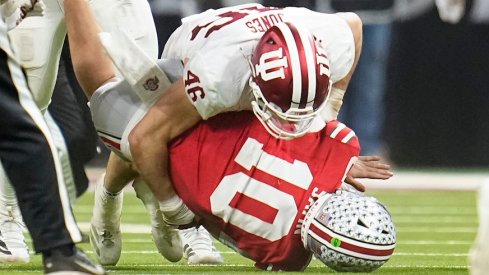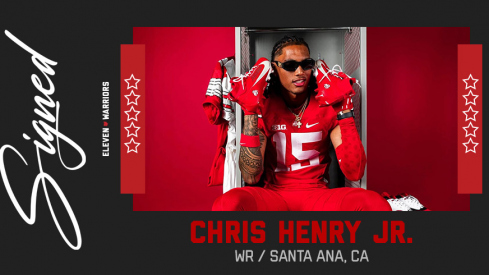
As with the offense, the defense had their own first quarter struggles last Saturday. This was mainly a result of two blown coverages, which resulted in big pass plays that can quickly overwhelm a defense. Credit also has to go to Zac Dysert and a Miami game plan that kept an OSU pass rush at bay. However, also like the offense, the defense made several subtle adjustments and cleaned up the secondary mistakes, allowing the Buckeye defense to largely shut down the Miami offense for the final three quarters.
If you are gonna bend, you can't break
Ohio State's defensive philosophy Saturday should have looked very familiar to observers of Ohio State's defenses over the last decade. Against Miami's "throw all the time" approach, Ohio State was almost exclusively in its 4-2-5 over nickel defense.
As seen above, this is an 'over' defense in that the defensive line shifts one gap towards the formation strength. For Ohio State, that means that their 3-technique and 'Viper' (Rush End) play to the strength, while the 1 and 5 technique play to the weakside (the opposite of OSU's base 4-3 under). The secondary, meanwhile, plays to the field, with the nickel back ('star') generally over the field-side slot.
OSU coverages were one of two varieties. The Buckeyes featured an extensive amount of cover 4, which is the biggest change from the Jim Heacock era.

Alternatively, OSU dropped the Viper (normally Nathan Williams) into coverage, rushed 3, and played a 3-deep, 5 under.
Meanwhile, Miami's coaching staff knew that their offensive line was overmatched versus Ohio State's defensive front so they did one of two things: They either employed a quick passing game, or half-rolled Dysert to get him away from the rush.
Miami's strategy was aided by Dysert's ability to move in the pocket to avoid pressure without disrupting his reads, an extremely underrated ability that defines a good quarterback. The upshot was that the Buckeyes began the game generating little pass rush against Dysert despite the Buckeye line being the defense's strength.
But this does not undermine the Buckeyes' defensive strategy, which is to force teams utilizing the quick game to string together short completions and move the football down the field. Ohio State did give up short completions. Particularly with cover-4, OSU's 3 underneath defenders (generally the linebackers) were unable to cover the underneath zones against the Miami wide receivers, allowing short completions. But as Urban Meyer stated, this is not debilitating:
The big ones no. The short ones, absolutely you have to rally up and make the receiver pay a price, and have to make the quarterback pay a price.
That's how you defend passes. What we did that as we developed a little bit. But, no, there's no excuse for a play, one was a blown coverage, the long one down the far sideline, Miami's sideline, and there was one that went right through the middle of our defense.
So there's no excuse for that whatsoever. However, you're going to give up yards, if they decide to throw every down, he'll throw for a lot of yards and be an NFL player, that quarterback.
The problem for Ohio State, as Meyer alludes to above, was that they had several coverage breakdowns that allowed big completions. For instance, here is the first long completion. OSU plays an 8-man coverage—3 deep, 5 under. Yet this added zone defender takes away from a pass rush but adds little when the defensive backs are not on the same page. Here, Travis Howard did not play the deep third of his zone, allowing the receiver to get behind him.
This is the worst of both worlds—focusing first and foremost upon coverage yet failing to execute.
Add a splash of pressure and a pinch of coverage
Ohio State was able to flip this script, however, through a combination of strategic adjustments and better execution. OSU upped the pressure to attempt to throw off Dysert's timing. OSU adjusted personnel, bringing Williams or Noah Spence in at LEO with Johnny Simon moving down to the 5 technique. Fellow freshman Aldolphus Washington also rotated in at 3-technique. These two freshmen displayed their immense potential and showed why Ohio State's defensive line is the deepest and most versatile unit on the team. Both will be crucial contributors to OSU this season, particularly in pass situations. Williams' return was also a welcome addition, bringing needed athleticism and versatility to the edge and as a great comeback from serious knee surgery.
OSU also moved from playing cover-4 to more cover-2. The goal was to put more defenders in the underneath zones to force Dysert to fit throws into tighter windows, taking away easy completions.
Finally, the Buckeye coaching staff mixed in a blitzing linebacker as a fifth rusher, looking to create an unblocked defender who could immediately bring inside pressure to Dysert and prevent him from side-stepping the rush.
The most crucial difference, however, was simply better execution in the secondary. Other than a nice use of formation by Miami where they formationed OSU's nickelback Corey Brown into single coverage against a four verticals route, the Buckeye secondary clamped down against such explosive (20+ yards) plays. As long as the secondary can do so, OSU's defensive philosophy can continue to function.
Continuing the Clean-Up Effort
Lapses in coverage amongst the Buckeye back seven also caused the OSU defense difficulties last fall. This unit must continue to improve to move Ohio State to the level of previous Ohio State defenses. The Buckeye defense figures to be stout against the run, as its defensive line will be difficult for any offense to contain. The defensive line's pass rush was also helped by a more liberal rotation of fresh bodies in the second half, which should be bolstered by the return of Michael Bennett. Spence and Washington's emergence and Williams' return in this regard are crucial, as they bring a high level of athleticism to their respective positions. Central Florida will provide the first opportunity for OSU to function from their base 4-3 under defense, and they will also provide a crucial test of Curtis Grant's play at Mike linebacker.

